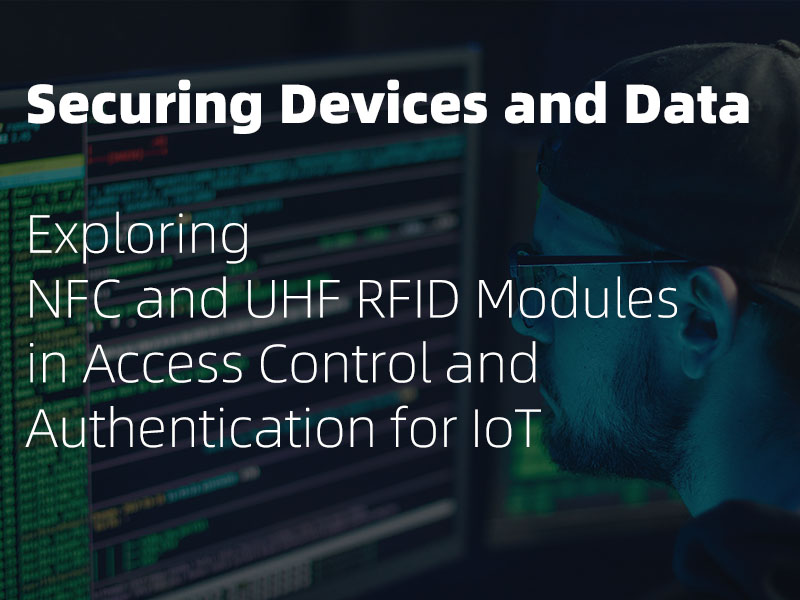Your location: Home Page > RFID Blog | SILION TECH > Securing Devices and Data: Exploring NFC and UHF RFID Modules in Access Control and Authentication for IoT
News and Information
Securing Devices and Data: Exploring NFC and UHF RFID Modules in Access Control and Authentication for IoT
Author:2024-05-17 18:45:13
In the rapidly expanding landscape of the Internet of Things (IoT), where billions of interconnected devices communicate and exchange data, ensuring robust security measures is paramount. Among the technologies at the forefront of IoT security are Near Field Communication (NFC) and Ultra-High Frequency (UHF) Radio-Frequency Identification (RFID). In this article, we'll delve into how NFC and UHF RFID modules are revolutionizing access control and authentication within the realm of IoT, safeguarding devices and data against unauthorized access and cyber threats.

Understanding NFC and UHF RFID in IoT Security
NFC and UHF RFID technologies offer distinct capabilities and advantages when it comes to IoT security:
NFC: Operating within the High-Frequency (HF) range, NFC enables short-range communication between devices, typically within a few centimetres. It is widely recognized for its ease of use, security features, and compatibility with smartphones and other consumer electronics.
UHF RFID: Operating at significantly higher frequencies, UHF RFID provides extended read ranges, making it suitable for applications requiring long-range identification and tracking. While traditionally used in supply chain management and asset tracking, UHF RFID holds immense potential for enhancing IoT security.
Advantages of NFC and UHF RFID in IoT Security
NFC:
Convenience: NFC facilitates seamless device pairing and authentication, allowing users to establish secure connections with IoT devices effortlessly.
Secure Communication: NFC supports encryption and authentication protocols, ensuring secure data exchange between devices and preventing eavesdropping or tampering.
Compatibility: With the widespread adoption of NFC-enabled smartphones, tablets, and wearables, integrating NFC into IoT devices enhances interoperability and user experience.
UHF RFID:
Extended Read Range: UHF RFID tags can be detected at distances ranging from several feet to over 30 feet, enabling efficient authentication and tracking of IoT devices in large-scale deployments.
Scalability: UHF RFID systems can accommodate a large number of devices simultaneously, making them ideal for IoT applications spanning smart cities, industrial automation, and logistics.
Cost-Effectiveness: UHF RFID tags and readers are cost-effective solutions for IoT deployment, offering high performance and reliability at scale.
Applications of NFC and UHF RFID in IoT Security
NFC:
Device Pairing and Configuration: NFC simplifies the setup process for IoT devices by enabling quick and secure pairing with smartphones or tablets, streamlining configuration and installation.
User Authentication: NFC-based authentication mechanisms enhance IoT device security by allowing authorized users to authenticate themselves using NFC-enabled credentials or tokens.
UHF RFID:
Asset Tracking and Management: UHF RFID tags embedded in IoT devices enable real-time tracking and monitoring of assets in smart logistics, inventory management, and industrial automation applications.
Access Control: UHF RFID systems provide robust access control solutions for securing IoT devices and infrastructure, preventing unauthorized access and ensuring compliance with security policies.
Strengthening IoT Security with NFC and UHF RFID
In the era of interconnected devices and digital transformation, the security of IoT ecosystems is paramount. By harnessing the capabilities of NFC and UHF RFID technologies, organizations can fortify their IoT deployments against emerging cyber threats and vulnerabilities.
Whether it's securing smart homes, industrial IoT networks, or smart city infrastructure, the integration of NFC and UHF RFID modules in access control and authentication mechanisms empowers organizations to safeguard devices and data, enhance user trust, and unlock the full potential of the Internet of Things.
As IoT continues to evolve and expand, the synergy between NFC and UHF RFID will play a pivotal role in shaping the future of IoT security, enabling a safer, more resilient, and interconnected world.
Next Article:How UHF RFID Modules Revolutionize Asset Management